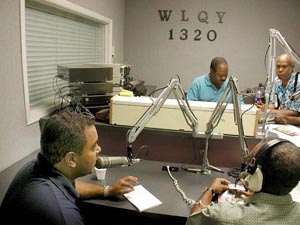Audio signal processing is a subfield of signal processing that is concerned with the electronic manipulation of audio signals. As audio signals may be represented in either digital or analog format, processing may occur in either domain. Analog processors operate directly on the electrical signal, while digital processors operate mathematically on the digital representation of that signal.

An effects unit or effects pedal is an electronic or digital device that alters the sound of a musical instrument or other audio source. Common effects include distortion/overdrive, often used with electric guitar in electric blues and rock music; dynamic effects such as volume pedals and compressors, which affect loudness; filters such as wah-wah pedals and graphic equalizers, which modify frequency ranges; modulation effects, such as chorus, flangers and phasers; pitch effects such as pitch shifters; and time effects, such as reverb and delay, which create echoing sounds.

Phase Alternating Line (PAL) is a colour encoding system for analogue television used in broadcast television systems in most countries broadcasting at 625-line / 50 field per second (576i). Other common colour encoding systems are NTSC and SECAM.

A sound effect is an artificially created or enhanced sound, or sound process used to emphasize artistic or other content of films, television shows, live performance, animation, video games, music, or other media. These are normally created with foley. In motion picture and television production, a sound effect is a sound recorded and presented to make a specific storytelling or creative point without the use of dialogue or music. The term often refers to a process applied to a recording, without necessarily referring to the recording itself. In professional motion picture and television production, dialogue, music, and sound effects recordings are treated as separate elements. Dialogue and music recordings are never referred to as sound effects, even though the processes applied to such as reverberation or flanging effects, often are called "sound effects".

Digital audio broadcasting (DAB) is a digital radio standard for broadcasting digital audio radio services, used in many countries around the world, though not North America.
Flanging is an audio effect produced by mixing two identical signals together, one signal delayed by a small and gradually changing period, usually smaller than 20 milliseconds. This produces a swept comb filter effect: peaks and notches are produced in the resulting frequency spectrum, related to each other in a linear harmonic series. Varying the time delay causes these to sweep up and down the frequency spectrum. A flanger is an effects unit that creates this effect.

Dynamic range compression (DRC) or simply compression is an audio signal processing operation that reduces the volume of loud sounds or amplifies quiet sounds thus reducing or compressing an audio signal's dynamic range. Compression is commonly used in sound recording and reproduction, broadcasting, live sound reinforcement and in some instrument amplifiers.

Digital Radio Mondiale is a set of digital audio broadcasting technologies designed to work over the bands currently used for analogue radio broadcasting including AM broadcasting, particularly shortwave, and FM broadcasting. DRM is more spectrally efficient than AM and FM, allowing more stations, at higher quality, into a given amount of bandwidth, using various MPEG-4 audio coding formats.
Logic Express was a "light" version of Logic Pro, a MIDI sequencer and digital audio workstation software application maintained by Apple that runs on the Mac OS X platform. It was announced on January 15, 2004 for release in March 2004.
The precedence effect or law of the first wavefront is a binaural psychoacoustical effect. When a sound is followed by another sound separated by a sufficiently short time delay, listeners perceive a single auditory event; its perceived spatial location is dominated by the location of the first-arriving sound. The lagging sound also affects the perceived location. However, its effect is suppressed by the first-arriving sound.

A telephone hybrid is the component at the ends of a subscriber line of the public switched telephone network (PSTN) that converts between two-wire and four-wire forms of bidirectional audio paths. When used in broadcast facilities to enable the airing of telephone callers, the broadcast-quality telephone hybrid is known as a broadcast telephone hybrid or telephone balance unit.
Television encryption, often referred to as "scrambling", is encryption used to control access to pay television services, usually cable or satellite television services.
Ducking is an audio effect commonly used in radio and pop music, especially dance music. In ducking, the level of one audio signal is reduced by the presence of another signal. In radio this can typically be achieved by lowering (ducking) the volume of a secondary audio track when the primary track starts, and lifting the volume again when the primary track is finished. A typical use of this effect in a daily radio production routine is for creating a voice-over: a foreign language original sound is dubbed by a professional speaker reading the translation. Ducking becomes active as soon as the translation starts.
Latency refers to a short period of delay between when an audio signal enters and when it emerges from a system. Potential contributors to latency in an audio system include analog-to-digital conversion, buffering, digital signal processing, transmission time, digital-to-analog conversion and the speed of sound in the transmission medium.
TC Electronic is a Danish audio equipment company that designs and imports guitar effects, bass amplification, computer audio interfaces, audio plug-in software, live sound equalisers, studio and post production equipment, studio effect processors, and broadcast loudness processors and meters.

Eventide, Inc. is an audio, broadcast and communications company in the United States whose audio division manufactures digital audio processors and DSP software, and guitar effects. Eventide was one of the first companies to manufacture digital audio processors, and its products are mainstays in sound recording and reproduction, post production, and broadcast studios.

WXTJ-LP is a Freeform formatted broadcast radio station licensed to and serving Charlottesville, Virginia, owned and operated by the University of Virginia.










